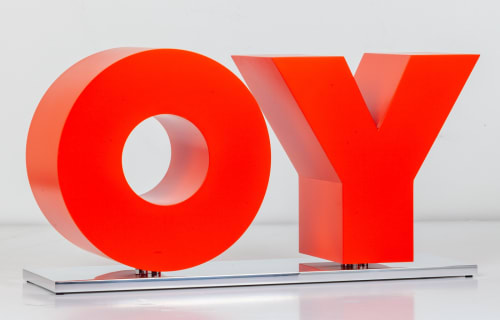
In an article on Flash Art last December, art historian and curator William J. Simmons conveyed the power of Pop Culture by connecting his relationship with Kurt and Blaine, the gay couple in Ryan Murphy’s TV show Glee, and the art of Deborah Kass: "I only really became gay when Kurt and Blaine finally kissed, and I think Kass makes me even gayer every time I see her paintings.”
Two works by Kass are prominently featured in Desire/Aspiration/Love/Rejection, the new Hook Art OVR opening today, which Simmons curated. The exhibition consists of seven “rooms,” with Kass’s work appearing under the heading Teenage Dream.
From the curator William J. Simmons:
I have an unrelenting desire to remember what it was like meeting a stranger after doing the same thing every day, all day, sitting in the same Dunkin’ Donuts under the J/M/Z train in Brooklyn, getting on the same train, sitting in the same windowless classroom in midtown and being told that my future depended on someone who wrote a shitty book many years ago. On bathroom breaks, themselves necessarily durational performances, I would check Grindr and Scruff and line up whatever had to be, should be done that night glamorously and perfunctorily, like I was working a double shift as a Lynchian waitress. But I had no such luck. Still, I was more of a curator in the traditional sense then than I am now, though my curatorial practice was, as it was and is for so many millennial cis gay men of a certain age, a fascist one afloat in notions of what the future ought to be like and the kinds of bodies that populate that future. Yet I am nostalgic. As art has taught us, there is much to be said for sameness.
At that time, I likewise had a sense of what art ought to be, and how it ought to love me or how it ought to allow me to love it. I was raised intellectually in a women’s studies program, leading me to lean all the way into bodies and their fluids and critiquing everything that emerges therefrom. For this reason, I am deeply grateful to follow Eric Shiner’s presentation on Hook’s platform. Then, when I moved to New York and started to become a part of the “art world,” I felt ugly and alone, and I espoused formalism as the antidote for looking at bodies that I find beautiful, be they plastic dolls or real cowboys or desolate landscapes or the arms of musicians, and learning that they could not ultimately be mine in reality or as metaphors.
Laurie Simmons, my longtime mentor and friend, has told me several times over the years that with age you are, hopefully, gentler on yourself. After years of disbelief, that finally came true. So, it no longer pains me so that I cannot possess or be what I love—in pictures or in flesh. I cannot be a sensual photographic emulsion in hues of black and grey or even a poem, really. I cannot be them, but I can be near them. For love is to be in proximity to something/someone, and not to fill their space with sameness, with selfsame versions of yourself. Yet everything in this exhibition is still a manifestation of my own journey, because this selection is definitely not some assertion that these artists are better, more historically important, secretly political, in need of a break from politics, whatever, etc. I maintain that, in the albeit masculinist theorization of the readymade, selection must not imply a hierarchy or any kind of exceptionalism. The balance then is realizing that everything, including history, is a chimera of one’s own individual desires, fears, lusts, etc., even as we allow the objects of our desire, despair, aspiration, and repulsion to echo infinitely with our blessing. We celebrate with they are met with love by others, and we ask empathetically why when they are rejected.
In short, we might encourage each other, and especially encourage young people, to approach curating as a constant process of self-forgiveness and self-love for one’s “taste.” I think this is what artists must learn to do, or else they die. We might likewise cautiously not choose death, or choose it only when it serves us, just as we might choose when and where to be political. We might no longer want an apartment in Brooklyn and instead dream of a ranch in Calabasas. We might want both or we might want nothing.
